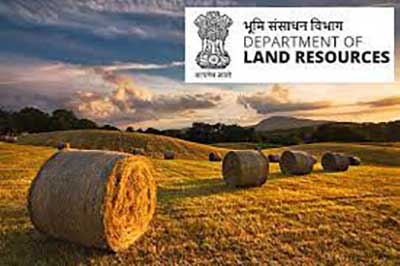Relevance: GS-3 Land reforms in India
Key phrases: Efficiency, Productivity, Consolidation, Co-operative Farming, Political Will, Ceiling Laws, Transparent
Why in News?
- Union Minister for Rural Development and Panchayati Raj discussed the various land management programs at the 'Bhumi Samvaad' - National Workshop on Digital India Land Record Modernization Programme (DILRMP).
- To encourage the good work done by the State Governments, the Department of Land Resources has also initiated the National Land Management Award – 2021.
- Department of Land Resources has also started national level ranking of States based on the best practices for land acquisition for infrastructure projects.
- This has been introduced to share the computerized digital land record data among different States/Sectors and a uniform system of assigning a unique ID to the land parcel across the country.
Consolidation of Landholdings
- Fragmented and subdivided landholdings as well as small-sized holdings have made Indian agriculture un-remunerative.
- So consolidation of these lands is necessary to boost efficiency and productivity of Indian agriculture.
- Till 2001, nearly, only 1/3rd of the total cultivated area has been consolidated (mainly successful in the region of Green Revolution).
- One of the reasons for the tardy progress of this aspect of land reforms is the fear of small farmers that consolidation favors large farmers. That is why the threat of eviction of tenants from land out of consolidation is the greatest.
Encouragement of cooperative joint farming:
- Cooperative farming did not receive any attention before the planning period although the congress Agrarian Reforms Committee had recommended cooperative farming for holdings below the ‘basic’ holding.
- The Progress was rather meagre. Up to 1965-66, a total of 7294 cooperative farming societies having a membership of 1.88 lakhs had been formed and these covered an area of 3.93 lakh hectares.
- However, many of these societies were defunct and some existed only on paper for the sake of obtaining state grants though their land was cultivated in the old way.
Reasons for the Failure of Land Reforms
- Due to the transfer of land to family members- In order to circumvent the ceiling laws zamindars transferred land to their family members.
- Land as a symbol of social prestige in India-People have emotional attachments with the land in India and it is not considered merely an economic asset unlike in other countries.
- Lack of Political Will- Under the pressure and directions of large farmers govts. were not interested in implementing the legislation enacted.
- Shortfalls in the Ceiling Laws- Levels of ceiling among different states and within different areas of the same state differed noticeably, which created confusions and frequent disputes.
- Indifference attitude of Bureaucracy- Lack of political will and indifference attitude of bureaucracy both are interlinked with each other. Bureaucracy has tried to play safe by aligning itself with large landlords.
- Dearth of Land Records- The reporting system of land records is irregular and there is no systematic review of progress at periodic intervals, sometimes even wrong record with mala-fide motives are retained.
Recent Land Reforms:
Land acquisition, rehabilitation and resettlement act 2013
- In this act the Compensation payment in rural areas was increased up to 4 times the market value, whereas, for urban areas up to 2 times. Also the Compensation to be provided to those who are dependent on the land for their livelihood.
- The Act has provisions to provide fair compensation to those whose land is taken away, brings transparency to the process of acquisition of land to set up factories or buildings, infrastructural projects and assures rehabilitation of those affected.
- The Act establishes regulations for land acquisition as a part of India's massive industrialization drive driven by public-private partnership.
Digital India Land Records Modernization Programme (DILRMP) 2008
- Digitization of land records was introduced to computerize all land records including mutations, improve transparency in the land records maintenance system, digitize maps and survey, update all settlement records and minimize the scope of land disputes.
- The main aim of the programme was to computerize all land records, digitize maps, upgrade the survey and settlement records and sustain the same.
- This would provide clear titles of land ownership that could be monitored easily by government officials, facilitate quicker transactions, and reduce disputes. Most importantly it would reduce construction timelines and overall cost for the developer, the benefits of which can be transferred to consumer making property prices more attractive.
- The Digital India Land Records Modernization Programme (DILRMP) was launched after the merger of two Centrally Sponsored Schemes viz.: Computerization of Land Records (CLR) & Strengthening of Revenue Administration and Updating of Land Records (SRA&ULR).
- The DILRMP has 3 major components
- Computerization of land record
- Survey/re-survey
- Computerization of Registration.
Unique Land Parcel Identification Numbers (ULPIN):
- Unique Land Parcel Identification Number (ULPIN) has been developed by NIC.
- ULPIN is a 14-digit Alpha–Numeric Unique ID for each land parcel. This is the next step in the Digital India Land Records Modernization Programme (DILRMP), which began in 2008.
- The identification will be based on the longitude and latitude coordinates of the land parcel, and is dependent on detailed surveys and geo-referenced cadastral maps.
National Generic Document Registration System (NGDRS)
- Advanced Application: NGDRS is an in-house advanced software application for the registration system developed by NIC.
- Compatible and transparent: This software application is scalable, flexible, configurable and compatible with the state-specific needs in the country.
- Integrated Land Management Information System (ILMIS) Project: This integrates all the processes and land records database with the banks, financial institutions, circle rates, Registration Offices and other sectors wherein all land-related information are available in a single window.
Sources: PIB ,The Hindu BL
Mains Question:
Q. Discuss in brief the land reforms which took place post-independence and reasons for their failure?









